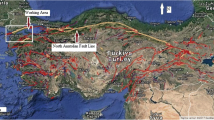Abstract
Fault traces have been previously located from measurements of 222Rn in soils taken a constant soil-depth across the fault trace. In this paper, we have studied the uranium-series disequilibria of the 226Ra, 222Rn (gas) and 214Bi radionuclides, not only for their horizontal spatial patterns across the fault trace, but also for their vertical spatial patterns near and at the fault trace itself. Radon-222 activities in the soil-gas were measured on-site with a radiation monitor and a Lucas cell. Radium-226 and 214Bi were determined in soil samples in the laboratory by gamma-ray spectroscopy. A new technique employing the measurement of 222Rn versus soil-depth shows a decrease in 222Rn activity at the fault trace due to the much higher soil-gas permeability as a result of the fractured soil, as well as relative larger uranium-series disequilibria, in respect to an increase in 222Rn activity at normal sites, where the soil is not fractured. Finally, it is suggested that fault trace detection could possibly also be performed by measuring 214Bi in surface soils (0-100 cm) along a transect.
Similar content being viewed by others
References
C-Y. King, J. Geophys. Res., 85 (1980) 3965.
C-Y. King, B-S. King, W. C. Evans, W. Zhang, Appl. Geochem., 11 (1996) 497.
G. Ciotoli, M. Guerra, S. Lombardi, E. Vittori, J. Geophys. Res., 103 (1998) 23, 781.
J. J. LaBrecque, P. A. Rosales, Geosci. Develop., (1996/1997) No. 4/5, 30.
H. Israel, S. Bjornsson, Z. Geophys., 33 (1967) 48.
C. Duenas, M. C. Fernandez, Tectonophysics, 152 (1988) 137.
C-Y. King, Nature, 271 (1978) 516.
B. J. Szabo, J. N. Rosholt, Appl. Geochem., 4 (1989) 177.
F. B. Riberiro, A. Roque, P. C. Boggiani, J-M. Flexor, Appl. Radiation Isotopes, 54 (2001) 153.
M. Ivanovich, R. S. Harmon, Uranium Series Disequilibrium: Applications to Earth, Marine and Environmental Sciences, 2nd ed., Oxford Science Publications, London, England, 1992.
J. J. LaBrecque, P. A. Rosales, P. R. Cordoves, J. Radioanal. Nucl. Chem., 253 (2002) 87.
J. J. LaBrecque, J. Radioanal. Nucl. Chem., 254 (2002) 439.
C. E. Junge, Air Chemistry and Radiochemistry, Academic Press, New York and London, 1963.
Author information
Authors and Affiliations
Rights and permissions
About this article
Cite this article
LaBrecque, J.J., Cordoves, P.R. Application of the relative uranium-series disequilibrium in soil to locate and/or confirm precisely active fault traces: A new technique. Journal of Radioanalytical and Nuclear Chemistry 258, 43–48 (2003). https://doi.org/10.1023/A:1026293606102
Issue Date:
DOI: https://doi.org/10.1023/A:1026293606102




